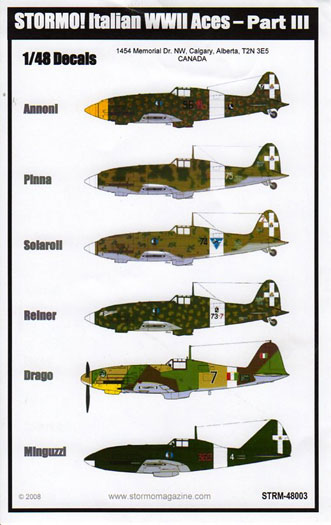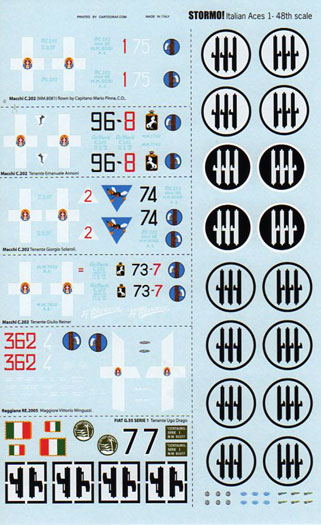Italian WWII Aces Pt. III

Stormo Decals, 1/48 scale
|
Summary |
|
Catalogue Number: |
Stormo Decals STRM-48003 - Italian WWII Aces Part III |
|
Scale: |
1/48 |
|
Contents and Media: |
Waterslide decals for six aircraft plus profiles, instructions and notes |
|
Price: |
USD$13.99 from Stormo Magazine |
|
Review Type: |
FirstLook |
|
Advantages: |
Excellent subject matter, printing, registration and detail |
|
Disadvantages: |
You will need separate research material, only a side profile given. |
|
Recommendation: |
Recommended, except for the Fiat G. 55 markings |
Reviewed by Steven "Modeldad" Eisenman

HyperScale is proudly supported by Squadron.com
The most recent set of decals in the Italian WWII Aces series from Stormo Magazine finally arrived by slow post. It is the third set of decals honoring Italian fighter aces of the Second World War.
Is this the final set? I’m not sure, and I hope not. After all, there were Aces who flew the Bf 109, Aces who served in the Aeronautica Nazionale Republicana (ANR) and Aces who flew for the Aeronautica Co-Belligerante. So, can we look forward to more Aces in different aircraft with different markings?
Like Part I and Part II, markings for various aircraft are given, although the Macchi C. 202 dominates. There are decals for the company logos on the propeller blades.
The markings are to be used in conjunction with the decals that came in the kits. The decals come with additional national markings of the correct color and style for the particular subject matter aircraft.
As with the previous sets, you only get the left profile view of each aircraft; there are no right, top or bottom views. Once again you are left to your own devices with regard to the camouflage on the tops of the wings and on the right side. However, for the most part, the camouflage application was fairly consistent across the airframe on five of the six aircraft.
The aircraft for which markings are given are the Macchi C. 202, the Fiat G. 55 Series I and the Reggiane Re. 2005.
The kits that one would use are the Hasegawa Macchi C. 202, Special Hobby / Flying Machines Fiat G. 55 (Note: the SH kit includes parts for both the Series 0 and I) and, the Flying Machines Reggiane Re. 2005.
Markings
 MACCHI C.202 FLOWN BY TENENTE EMANUELE ANNONI; MACCHI C.202 FLOWN BY TENENTE EMANUELE ANNONI;
96a Squadriglia, 9° Gruppo, 4° Stormo CT: Comiso; October 1941. This aircraft carries the “poached egg” or “fried egg” scheme. The base color is Verde Mimetico 3 (Green 3) with splotches of Giallo Mimetico 4 (Yellow 4) and splotches of Bruno Mimetico (Brown) applied on the Giallo splotches. The underside is Grigio Mimetico (Gray).
The aircraft is characteristic of the early Serie II / III Macchi C.202 fighters. It had the short radio mast and lacked a sand filter, having the straight long intake.
MACCHI C.202 FLOWN BY CAPITANO MARIO PINNA;
75a Squadriglia 23° Gruppo, 3° Stormo CT; Abu Haggag, Egypt; September, 1942. The aircraft is in a modified Breda “branch-style” scheme. The base is Nocciola Chiaro (Light Hazelnut) with Verde Oliva Scuro (Dark Olive Green) splotches. The Verde Oliva Scuro was originally applied in the pattern as shown on the third aircraft, but was modified by a more extensive application of the Verde Oliva Scuro. The underside is Grigio Azzurro Chiaro (light Blue-Gray).
MACCHI C.202 SERIE VIII FLOWN BY TENENTE GIORGIO SOLAROLI (MARCHESE DI BRIONA);
74a Squadriglia, 23° Gruppo, 3° Stormo CT; Abu Haggag, Egypt; September, 1942. The aircraft is in the Breda “branch-style” scheme. The base is Nocciola Chiaro (Light Hazelnut) with small, irregular Verde Oliva Scuro (Dark Olive Green) splotches. The underside is Grigio Azzurro Chiaro (light Blue-Gray).
MACCHI C.202 FLOWN BY TENENTE GIULIO REINER, CO;
73a Squadriglia, 9° Gruppo, 4° Stormo CT; Fuka, Egypt; July, 1942. This aircraft is in the Macchi production camouflage scheme of Verde Oliva Scuro (Dark Olive Green) base with small Nocciola Chiaro (Light Hazelnut) splotches. The underside is Grigio Azzurro Chiaro (light Blue-Gray).
The port / left aileron on this aircraft was a replacement aileron painted in the C8 Scheme, which is the “poached / fried egg” pattern shown on the first aircraft. This would also mean that the underside of the aileron would most likely be in Grigio Mimetico, rather then the Grigio Azzurro Ghiaro color. It also should be noted that the port / left side panel on the radiator was in unpainted metal.
FIAT G.55 SERIE I FLOWN BY TENENTE UGO DRAGO;
1a Squadriglia, 2° Gruppo CT; Cascina Vega, Italy; May 1944. This aircraft was finsied in the ANR experimental splinter scheme. It is believed that the colors used were Verde Mimetico 1 (Green 1), Giallo Mimetico 3 (Yellow 3) and Marrone Mimetico 1(Maroon 1). The undersides are Grigio Azzuro Chiaro (Light Blue-Gray).
WARNING: The ANR marking are wrong, especially the flag. The flag is printed backwards. The green should be forward in all positions and the forward vertical edge should be the solid staff, not the fringe. The instructions show the red in the forward position, with the forward edge in the solid staff. Not even reversing the application will correct this problem, as the green vertical edge is fringed. The flags in the Special Hobby kit may be used.
The other issue is the wing markings. My research indicates that the Fiat factory application was a solid black border. The Stormo decals have a ‘stenciled’ border. The stencil style was used without a white background. The wing-top decals that come with the Special Hobby kit are not appropriate either for Drago’s aircraft, as the SH wing-top marking was a somewhat unique filed applied marking. The under-wing decals are appropriate.
The next issue is the lack of a diagram for applying the complex splinter scheme. However, the absence of a top view of this scheme may not be as problematic as one might believe. Further research indicates that while it is assumed that this aircraft was in a pattern common to those located at Cascina Vega, there is no clear picture showing that Drago’s aircraft was actually in this scheme.
To muddy the issue further, I went to the excellent Camouflage and Markings of the Aeronautica Nazionale Republicana (ANR), by D’Amico and Valentini, only to discover that the artist’s rendering of the overhead view of the “Cascina Vega pattern”, did not match the left side profile in the book. This issue was particularly acute on the forward fuselage. Even if the top view was correct, one would still lack a right side pattern.
Assuming that any pattern for Drago’s aircraft is conjectural, one might as well just rely on the diagram that comes with the Special Hobby kit.
I also have an issue with the “Gigi Tre Osei” unit badge for the nose. Stormo has it with a dark green background. Given this is the late Serie I aircraft, it is entirely possible that the scheme was applied at the factory and that the unit badge was applied as a white stenciling, allowing the camouflage color underneath to show through. But there is nothing conclusive one way or the other.
The reason for the green background on the Stormo badge decal is because it is believed the earliest applications of this experimental scheme was field applied over the original Verde Oliva Scuro camouflage with the badge being masked.
The Special Hobby “Gigi Tre Osei” badge also appears to be inappropriate, even for an early repaint as it is on a black background.
The square that has the aircraft serial number also, perhaps, should have been on a black background.
It really is a shame that for this aircraft, one is left with just the aircraft number “7” as the only decals that may be usable.
REGGIANE RE.2005 FLOWN BY MAGGIORE VITTORIO MINGUZZI;
363a Squadriglia, 22° Gruppo CT, Sigonella, Italy; July 1942. This is the basic Reggiane scheme of Verde Olivo Scuro (Dark Olive Green) on top with Grigio Azzuro Chiaro (Light Blue-Gray) undersides.
This aircraft is the prototype Re. 2005, as such it had the pre-production canopy with two ribs on top, instead of one.
Unlike other Re. 2005 aircraft of this unit, this aircraft did not have the “Sagittario” on the fin and it did not have the Scarecrow emblem on the white fuselage band.
For five out of six aircraft, Stormo has produced another excellent collection of markings. You may also not have to make as much of an effort to check resources when using these decals.
As was the case with Part II, decals are well packaged in a plastic envelope with a thick sheet of plastic to make the envelope fairly ridged.
I do hope this is not the last in this series. I would love to see a set for the Bf 109s, the ANR and the Co-B aces.
Thanks to Vince Tassone for the review sample.
Review Copyright © 2008 by Steven "Modeldad" Eisenman
This Page Created on 16 October, 2008
Last updated 16 October, 2008
Back to HyperScale
Main Page
Back to Reviews
Page |
Home
| What's New | Features | Gallery | Reviews | Reference | Forum | Search